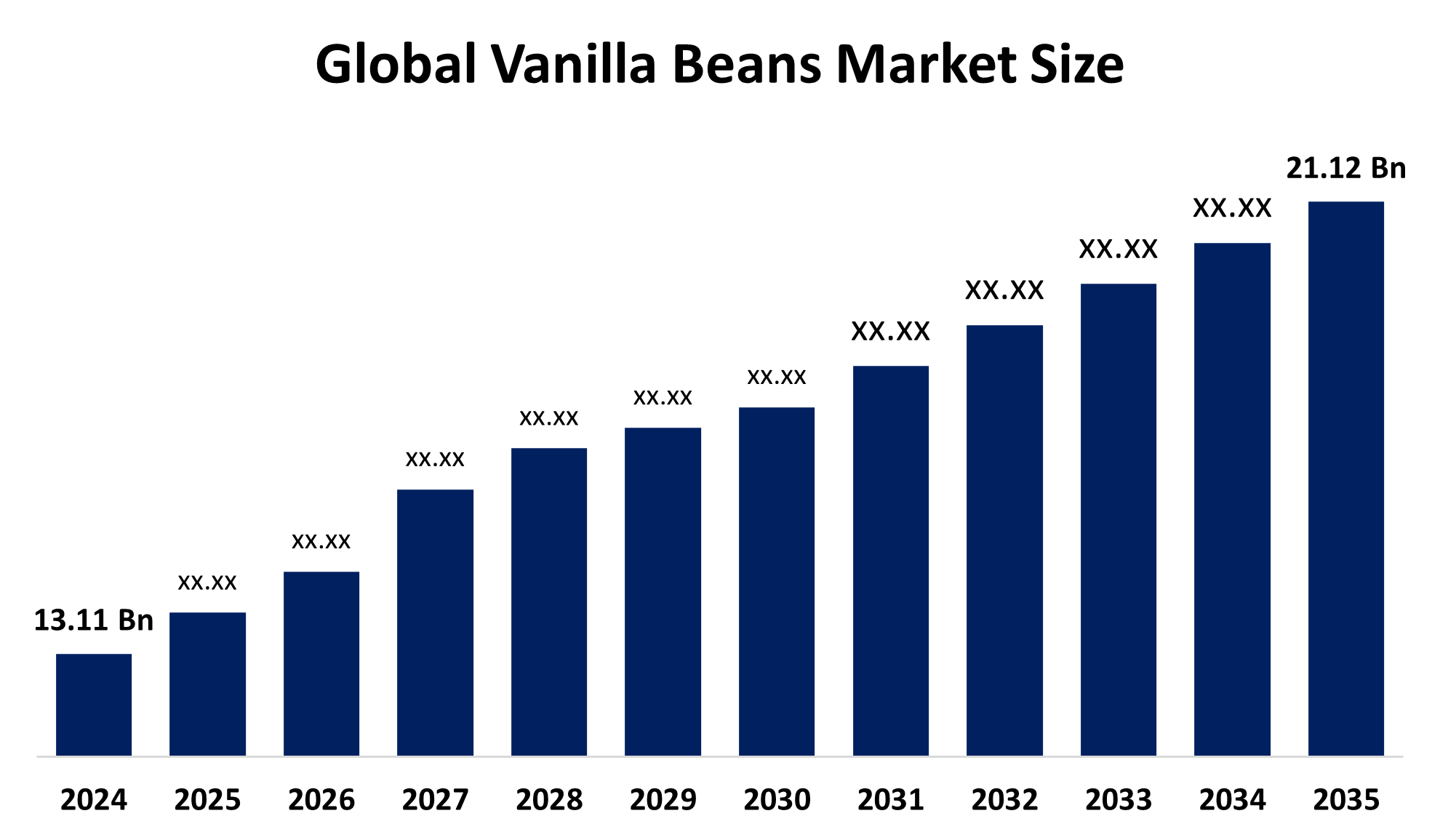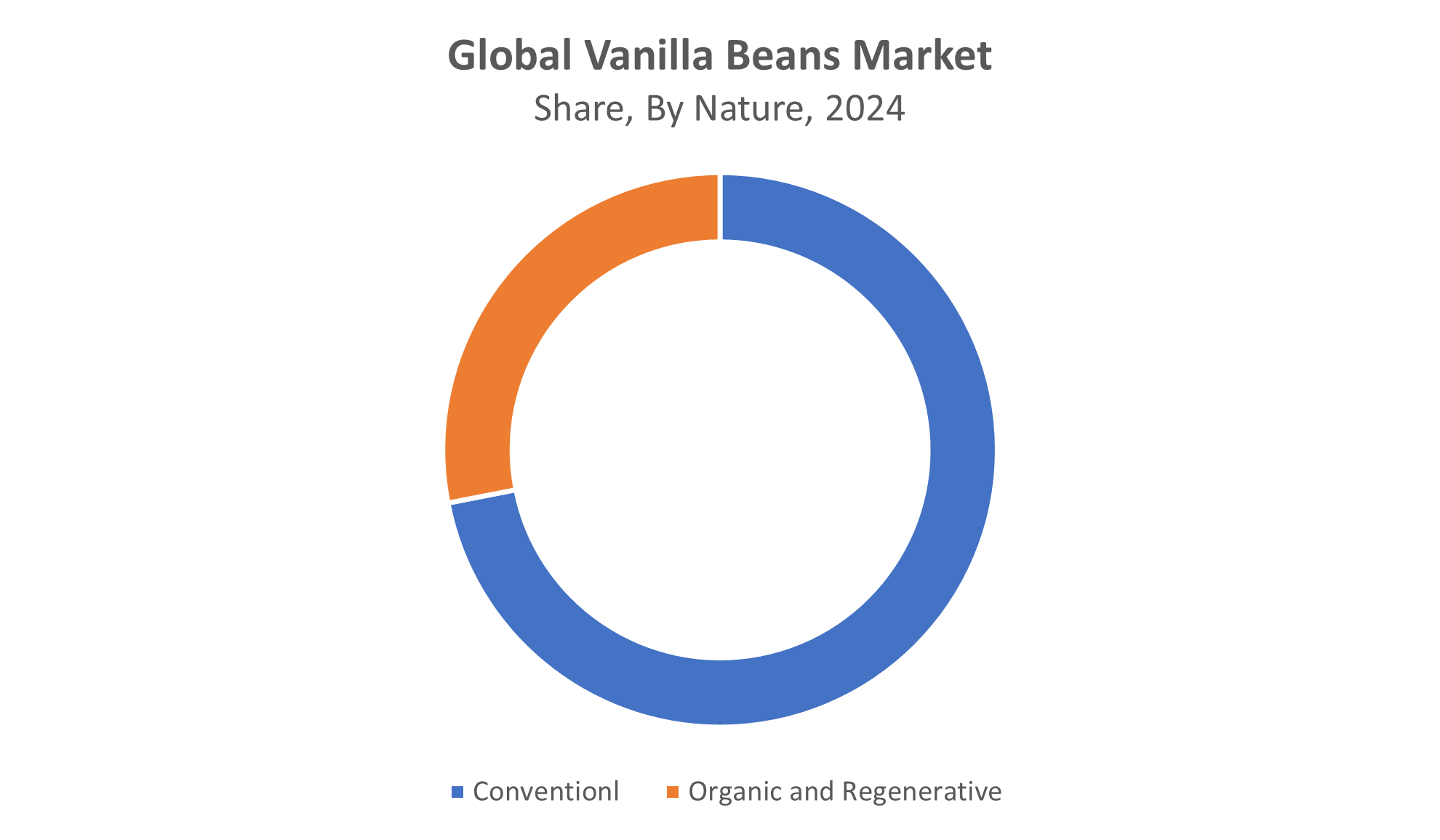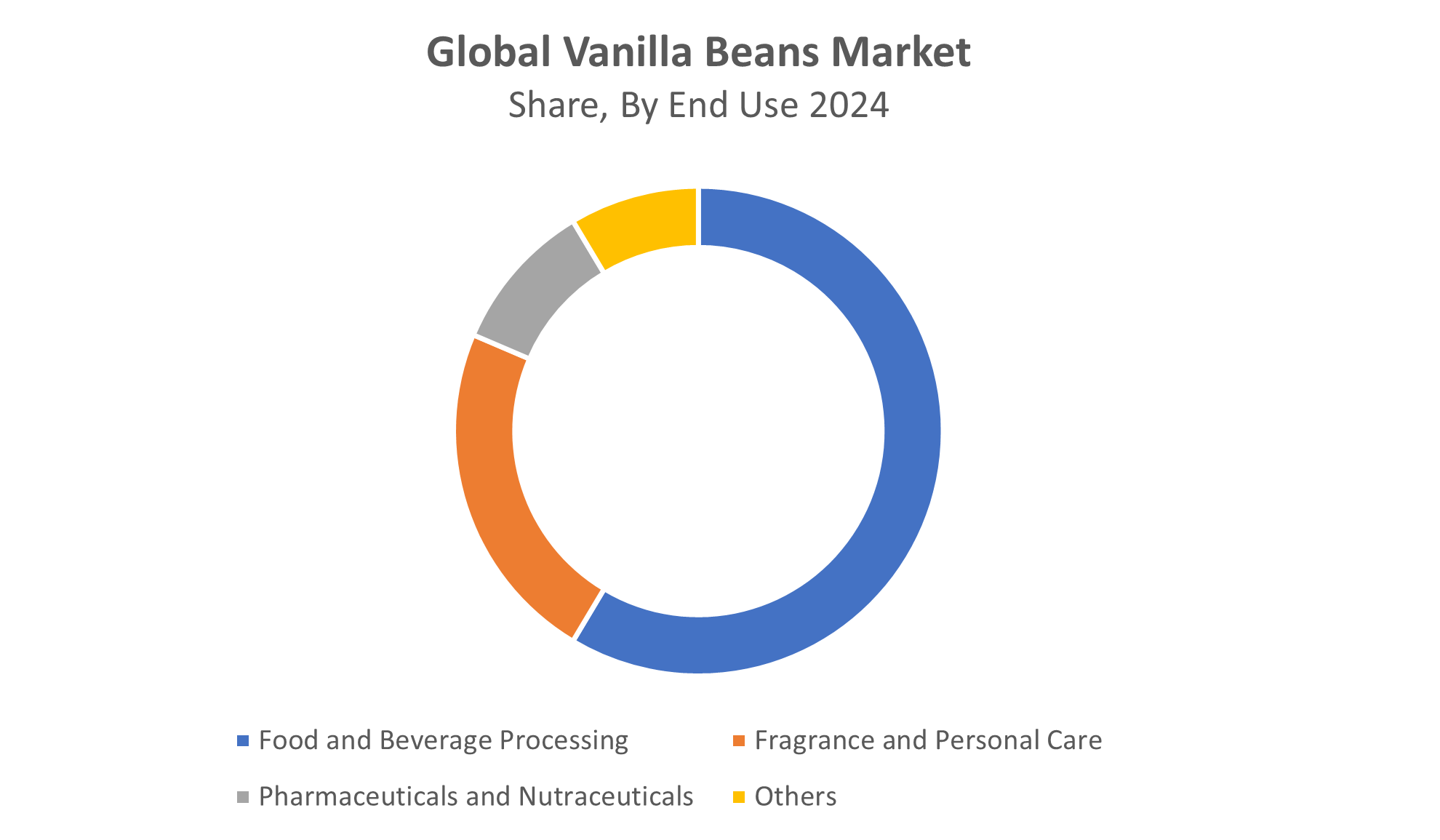Global Vanilla Beans Market Size, Share, and COVID-19 Impact Analysis, Russia-Ukraine War Impact, Tariff Analysis, By Bean Species (Vanilla Planifolia, Vanilla Tahitensis, and Others), By Nature (Conventional, Organic and Regenerative), By End Use (Food and Beverage Processing, Fragrance and Personal Care, Pharmaceuticals and Nutraceuticals, and Others), and By Region (North America, Europe, Asia-Pacific, Latin America, Middle East, and Africa), Analysis and Forecast 2025 - 2035.
Industry: AgricultureVanilla Beans Market Summary, Size & Emerging Trends
According to Spherical Insights, The Global Vanilla Beans Market Size is Expected To Grow from USD 13.11 Billion in 2024 to USD 21.12 Billion by 2035, at a CAGR of 4.43% during the Forecast Period 2025-2035. Increased consumer desire for natural flavors, growing uses in premium and organic products, and growing demand in food, cosmetics, and pharmaceuticals all present opportunities for development for the vanilla beans market.
Key Market Insights

Get more details on this report -
- Asia Pacific is expected to account for the largest share in the vanilla beans market during the forecast period.
- In terms of bean species, the vanilla planifolia segment is projected to lead the vanilla beans market in terms of equipment throughout the forecast period
- In terms of Nature, the conventional segment captured the largest portion of the market
- In terms of end use, the food & beverages processing segment captured the largest portion of the market
Global Market Forecast and Revenue Outlook
- 2024 Market Size: USD 13.11 Billion
- 2035 Projected Market Size: USD 21.12 Billion
- CAGR (2025-2035): 4.43%
- Asia Pacific: Largest market in 2024
- North America: Fastest growing market
Vanilla Beans Market
The global commercial trade and business that involves the production, processing, distribution, and sale of vanilla beans is referred to as the "vanilla beans market." Originating from the pods of the Vanilla orchid, vanilla beans are prized for their fragrant qualities and are mostly used as a natural flavoring agent in a variety of industries, including food and drink, cosmetics, and pharmaceuticals. This market includes a wide variety of participants, such as farmers, exporters, manufacturers, and retailers, who support the supply chain from the manufacturing of raw beans to the final products. The increasing need for natural flavor enhancers in newborn feeding and the high demand for luxury ice cream are the main factors driving the vanilla beans market. The market for vanilla beans is presently being driven by consumers' growing desire for natural tastes in food and drink items. Furthermore, the culinary industry is adopting vanilla as a fundamental flavor, propelling expansion in a number of applications, such as beverages, sweets, and pastries. The market for vanilla beans is expanding significantly due to consumers' preference for natural flavors over synthetic ones.
Vanilla Beans Market Trends
- The market expansion in the food, beverage, and cosmetic sectors is being driven by consumers' growing preference for natural and organic vanilla products.
- The quality and output of vanilla beans are being improved by technological developments in cultivation and processing techniques.
- Global demand for premium vanilla beans is being driven by the growth of the specialized and premium cuisine sectors.
- Climate-related factors and controlled growing areas cause price volatility for vanilla beans, which concerns supply chain tactics and market stability.
Vanilla Beans Market Dynamics
Vanilla Beans Market Report Coverage
| Report Coverage | Details |
|---|---|
| Base Year: | 2024 |
| Market Size in 2024: | USD 13.11 Billion |
| Forecast Period: | 2025-2035 |
| Forecast Period CAGR 2025-2035 : | 4.43% |
| 2035 Value Projection: | USD 21.12 Billion |
| Historical Data for: | 2020-2023 |
| No. of Pages: | 216 |
| Tables, Charts & Figures: | 137 |
| Segments covered: | By Type and By Material |
| Companies covered:: | ADM, Kitchodo, Venui, Symrise AG, Sambavanilla, Givaudan, Eurovanille, Vanilla Bean Project, Laie Vanilla Company, Naigai Flavors Co., Ltd., Golden Kelly Pat. Flavor Co., Ltd., Nielsen-Massey Vanillas, Inc., Others, and |
| Pitfalls & Challenges: | COVID-19 Impact, Challenges, Future, Growth, & Analysis |
Get more details on this report -
Driving Factors: Demand is Increased by Premium Ice Cream and Skincare Brands
The market expansion for vanilla beans is being driven mostly by the growing demand for high-end ice cream and clean-label skincare products. Vanilla continues to be the most popular flavor in premium ice cream, both on its own and as a base ingredient in intricate concoctions. Indirectly improving supply stability for the vanilla bean market, traceability also supports living-income price mechanisms that maintain smallholder incomes. Natural vanilla is in high demand due to the growing customer preference for clean-label goods and organic ingredients. Additionally, more sectors are adopting natural vanilla as a result of growing awareness of its health benefits, especially its antioxidant qualities.
Restrain Factors: High costs and labor limit vanilla production.
A number of limitations, such as the high cost of cultivation and the labor-intensive harvesting method, limit the market for vanilla beans and prevent large-scale manufacturing. Consistent output is also impacted by the crop's vulnerability to pests and climate changes. Market stability is hampered by price volatility, which is fueled by a small number of growing locations and erratic supply. Additionally, the availability of cheaper synthetic vanilla substitutes might restrict expansion by affecting the market for natural vanilla beans.
Opportunity: Rising demand for natural products boosts vanilla.
The growing consumer desire for natural and organic products across a range of industries, including food, drinks, cosmetics, and medicines, presents substantial potential opportunities for the vanilla bean market. Manufacturers are being encouraged to use vanilla beans in their formulas by growing awareness of the health advantages of natural flavoring agents. Opportunities to increase output and quality are presented by technological developments in farming and processing methods. Furthermore, there is unrealized potential for global market expansion in emerging nations with rising disposable incomes and changing consumer tastes.
Challenges: Pests and climate change damage vanilla crop quality.
The market for vanilla beans is vulnerable to pest infestations and climate change, which hurt crop quality and productivity. Scalability is limited by the labor-intensive planting and harvesting procedures, which raise production costs. Uncertainty is also created for stakeholders by price volatility brought on by growth-restricted regions and supply-demand imbalances. Synthetic vanilla substitutes present a serious threat as well since they are more reasonably priced and may lessen market demand for natural vanilla beans.
Global Vanilla Beans Market Ecosystem Analysis
The ecosystem of the global vanilla bean market includes important players like producers, distributors, exporters, growers, and processors. The entire supply is impacted by the concentration of cultivation in particular areas with ideal climates. Processors turn unprocessed beans into goods with added value for the food, cosmetics, and pharmaceutical industries. Exporters and distributors connect producers with consumers around the world, facilitating international trade. Agricultural practices, price swings, technical developments, and growing customer preference for natural ingredients are some of the elements that influence market dynamics. Meeting rising demand and preserving market stability require efficient supply chain management and sustainable agricultural methods.
Global Vanilla Beans Market, By Bean Species
The vanilla planifolia segment led the vanilla beans market, generating the largest revenue share. The prevalence of vanilla planifolia and the depth of agricultural expertise among farmers in Madagascar, Indonesia, and Uganda. Vanilla planifolia is an orchid species that is grown mainly for its pods, which are the main source of vanilla taste at home. It needs particular growing conditions and does well in tropical climes.
The vanilla tahitensis segment in the vanilla beans market is expected to grow at the fastest CAGR over the forecast period. Vanilla tahitensis is a unique type of vanilla orchid distinguished by its larger, plumper pods and distinctive fragrance profile. It is primarily grown in tropical areas like Tahiti and is prized for its high-end flavoring uses in the food, fragrance, and cosmetics sectors.
Global Vanilla Beans Market, By Nature
The conventional segment held the largest market share in the vanilla beans market. The traditional farming methods' wider availability, greater yield rates, and established growing techniques are the reasons behind the conventional category. In addition, compared to organic and regenerative options, the conventional segment enjoys cheaper manufacturing costs and larger supply chains.

Get more details on this report -
The organic segment in the vanilla beans market is projected to register the fastest CAGR. The market for organic vanilla beans is fueled by growing customer demand for natural and sustainably sourced products, as well as growing knowledge of the health advantages of these products.
Global Vanilla Beans Market, By End Use
The food and beverage processing segment held the largest market share in the vanilla beans market. The extensive usage of vanilla as a natural flavoring agent in a wide range of products, including dairy, baked products, beverages, and confections, is credited with driving the food and beverage processing market. Growing customer preferences for natural and organic ingredients are contributing to the segment's growth by encouraging producers to use vanilla beans in their products.

Get more details on this report -
The fragrance and personal care segment in the vanilla beans market is projected to register the fastest CAGR. The growing demand for natural and sustainable components in cosmetic and personal care products, which is pushing up demand for aromatic compounds produced from vanilla worldwide, is responsible for the fragrance and personal care category.
Asia Pacific is expected to account for the largest share of the vanilla beans market during the forecast period.

Get more details on this report -
The Asia-Pacific region is credited with both the growing consumer desire for natural and organic products in nations like China, Japan, and India, as well as the region's ideal climate, which encourages the production of vanilla. The growing middle classes in China and India reinforce volume growth by incorporating vanilla into ready-to-drink coffee, nutraceutical sachets, and Western-style bakery businesses.
India is experiencing steady growth in the vanilla beans market. India's growth is supported by conducive climatic conditions for cultivation, rising consumer preference for natural and organic products, and expanding usage of vanilla beans in food, beverage, cosmetics, and pharmaceutical sectors, driving market demand.
North America is expected to grow at the fastest CAGR in the vanilla beans market during the forecast period. The main factor driving this trend in North America is the growing consumer preference for natural and organic substances in foods, drinks, cosmetics, and medications. Demand is also being driven by growing applications of natural vanilla in upscale and artisanal products as well as growing awareness of its health advantages.
The United States is the largest market for vanilla beans is attributed to the country’s substantial consumer demand for natural and organic products, alongside a well-established food, beverage, and cosmetics industry that extensively utilizes vanilla beans as a key flavoring ingredient.
Competitive Analysis:
The report offers the appropriate analysis of the key organizations/companies involved within the vanilla beans market, along with a comparative evaluation primarily based on their type of offering, business overviews, geographic presence, enterprise strategies, segment market share, and SWOT analysis. The report also provides an elaborate analysis focusing on the current news and developments of the companies, which includes product development, innovations, joint ventures, partnerships, mergers & acquisitions, strategic alliances, and others. This allows for the evaluation of the overall competition within the market.
WORLDWIDE TOP KEY PLAYERS IN THE VANILLA BEANS MARKET INCLUDE
- ADM
- Kitchodo
- Venui
- Symrise AG
- Sambavanilla
- Givaudan
- Eurovanille
- Vanilla Bean Project
- Laie Vanilla Company
- Naigai Flavors Co., Ltd.
- Golden Kelly Pat. Flavor Co., Ltd.
- Nielsen-Massey Vanillas, Inc.
- Others
Key Target Audience
- Market Players
- Investors
- End-users
- Government Authorities
- Consulting And Research Firm
- Venture capitalists
- Value-Added Resellers (VARs)
Product Launches in Vanilla Beans
- In June 2025, The Art of Vanilla, a new line of premium vanilla ingredients, was launched by Flavorchem, a flavor and ingredient supplier. The goal of this portfolio is to demonstrate vanilla's appeal and adaptability without sacrificing quality.
Market Segment
This study forecasts revenue at global, regional, and country levels from 2020 to 2035. Spherical Insights has segmented the vanilla beans market based on the below-mentioned segments:
Global Vanilla Beans Market, By Bean Species
- Vanilla Planifolia
- Vanilla Tahitensis
- Others
Global Vanilla Beans Market, By Nature
- Conventional
- Organic and Regenerative
Global Vanilla Beans Market, By End Use
- Food and Beverage Processing
- Fragrance and Personal Care
- Pharmaceuticals and Nutraceuticals
- Others
Global Vanilla Beans Market, By Regional Analysis
- North America
- US
- Canada
- Mexico
- Europe
- Germany
- UK
- France
- Italy
- Spain
- Russia
- Rest of Europe
- Asia Pacific
- China
- Japan
- India
- South Korea
- Australia
- Rest of Asia Pacific
- South America
- Brazil
- Argentina
- Rest of South America
- Middle East & Africa
- UAE
- Saudi Arabia
- Qatar
- South Africa
- Rest of the Middle East & Africa
Frequently Asked Questions (FAQ)
-
1.What is the CAGR of the vanilla beans market over the forecast period?The global vanilla beans market is projected to expand at a CAGR of 4.43% during the forecast period.
-
2.What is the market size of the vanilla beans market?The global vanilla beans market size is expected to grow from USD 13.11 billion in 2024 to USD 21.12 billion by 2035, at a CAGR of 4.43% during the forecast period 2025-2035.
-
3.Which region holds the largest share of the vanilla beans market?Asia Pacific is anticipated to hold the largest share of the vanilla beans market over the predicted timeframe
-
4.Who are the top 10 companies operating in the global vanilla beans market?Key players include ADM, Kitchodo, Venui, Symrise AG, Sambavanilla, Givaudan, Eurovanille, Vanilla Bean Project, Laie Vanilla Company,Naigai Flavors Co., Ltd., Golden Kelly Pat. Flavor Co., Ltd., Nielsen-Massey Vanillas, Inc., and Others.
-
5.What factors are driving the growth of the vanilla beans market?The vanilla beans market is driven by rising demand for natural flavorings, growing food and beverage industry, premium product trends, increased consumer awareness, and expanding applications in cosmetics and pharmaceuticals
-
6.What are the main challenges restricting wider adoption of the vanilla beans market?The vanilla beans market faces challenges such as high production costs, price volatility, vulnerability to climate change, limited supply sources, labor-intensive cultivation, and risks of adulteration and quality inconsistencies.
Need help to buy this report?